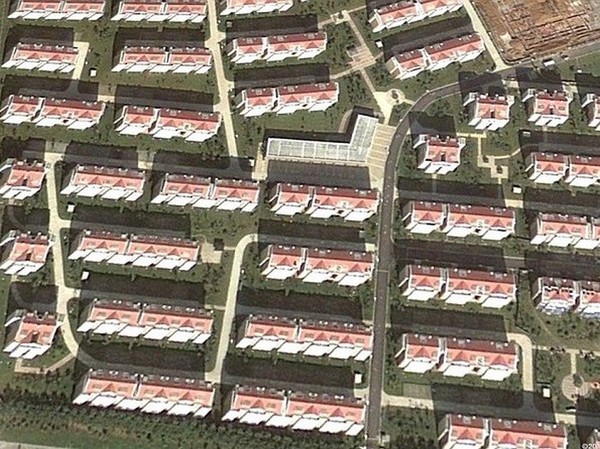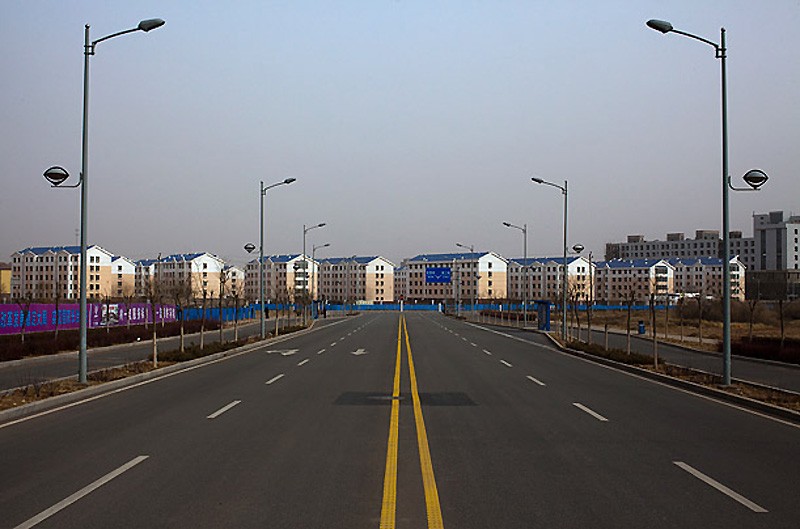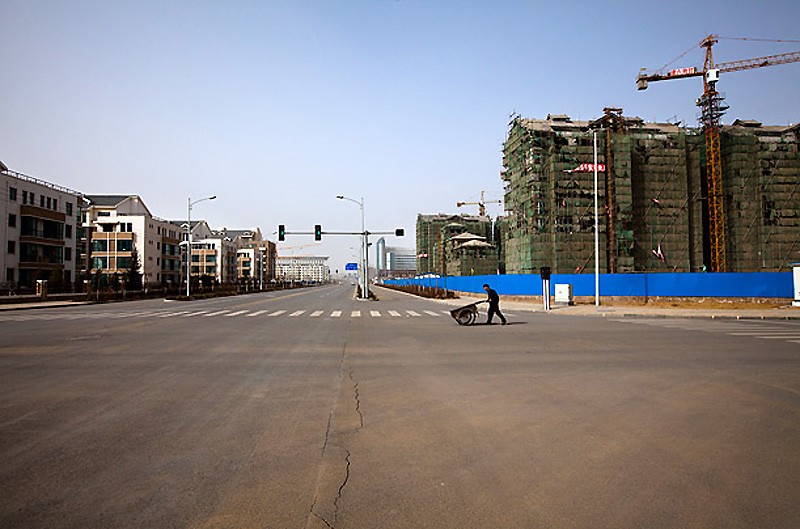|
View: 2515|Reply: 10
|
China's Ghost Towns (12 photos)
[Copy link]
|
|
|
You have all probably heard about the ghost towns in China. Here are pictures of walking around the internet.

Why China is building large, well-thought-out ghost towns that are completely empty?
Photos with Google Earth city after city portray a huge complex consisting of office skyscrapers, government buildings, residential buildings, residential towers and houses, all connected by a network of empty roads, and some cities are located in the most inhospitable places in China.

Images of these ghost towns (after countless billions of dollars spent on design and construction) show that they have no one lives.

Photos look like a giant film set, prepared for the filming of some apocalyptic movie where an unknown neutron strike or a natural disaster has destroyed the people, leaving the skyscrapers, sports stadiums, parks and roads perfectly intact. One of these cities generally built in the middle of the desert, in the inner Monogolii. "

Business Insider has published a series of photographs of Chinese ghost towns. Neither one of these cars is not observed, except for about 100 pieces, parked on a large vacant lot near the government building, and another one, which depicts a beautiful park, and added to the photo editor people.
In China now, according to some estimates about 64 million empty homes. In his "vast areas of available land," China is building 20 new ghost towns in the year.

Everything would be fine, but I then came across what is delusional explanation of the circumstances. Just listen!
Currently China has about 100 megacities. These svezhepostroennye ghost towns are a reserve fund to the public. In the event of war. Bomb them does not make sense, there are many more important goals. And on the existing residential city is sure to be hit, and probably nuclear. Restore them in time of war is costly, and such huge masses of people in the cracks did not raspihat. It is much more profitable and easier to rebuild the entire city with the necessary infrastructure in advance, and at the right time to evacuate the population and the surviving remnants of the equipment from the factories and mills.
But there is a very unpleasant time. Maintain order
Let's all still revere the real version.
Dai District Huizhou, Guangdong Province town covers an area of ​​20 square meters. miles. For several years he was actively built up and has a fully-formed infrastructure. However, for several years now there are empty 70% of living space, which made it a real "ghost town".
According to Chinese newspaper "Daily Economic News", a new area of ​​Daya is located 70 km from the metropolis Shenzhen, just a few years he has been completely built up as a residential and administrative and business buildings. However, the wide streets between the high-rise buildings are very rare to find a passer-by.
As property prices in this area is 4-5 times lower than in neighboring Shenzhen, metropolitan residents have bought an apartment here. But they did it solely as an investment, hoping that by the time the price of this property will rise. They themselves do not live there, only occasionally visited by.
Their assumptions were correct, the last few years property prices in the area jumped by more than two times. The average square meter now costs 5,000 yuan ($ 714).

The new city is similar to the area after the epidemic, which has survived a small portion of the population. In the windows of apartment buildings where you can rarely see the light.
"It's all apartments have long been sold, but most owners do not live in them. Permanent residents are less than 20% of tenants, "- said the guard of one of the neighborhoods.
Locals joke: "We've got nothing grows, except for empty houses."
Forensic Asia Limited Company in their report indicates the existence in China of many vacant areas, the so-called "ghost towns".
The new district Chzhendun Shenzhou city, Henan province has been called the largest "ghost town" as well as a landmark district of the housing bubble in China. The area started to build in 2003, it covers an area of ​​150 sq. km. miles. For several years, he settled in less than 40%.
Once this information was widely publicized in the media, a local official in an interview with "China Business" totally rejected it. In turn, he said that currently the level of colonization of new buildings is 90%, while the number of residents Chzhendun has already exceeded 300 thousand people.
However, according to the same authorities, has now been built more than 30% of the planned development district, and given the level of official population of just 7.5% of the planned number of people that by 2020, according to the project must be 4 million people .

Last year, Chinese media reported that the State Power Grid Company of China conducted a survey in 660 cities. The result revealed that the electric meters 65.4 million apartments for six months, the zero reading. This suggests that the flats no one lives. These apartments enough to live 200 million people.
Chinese economist Xie Gochzhun believes that blank in China are 25% - 30% of new buildings. According to him, the area of ​​residential buildings in Chinese cities is 17 million square meters. m, which is sufficient for the resettlement of residents of China.
When the financial crisis, many Chinese businessmen began to transfer their money out of production in real estate, to somehow avoid bankruptcy. Thus, the number of houses and apartments in the country it was purchased only for investment. But that's the main reason was a sharp rise in property prices, which the authorities are still unable to take control.
The fact that some time because of the construction boom and diminish the appetite of developers and the possibility of the global economic crisis originated in China unprecedented type of ghost towns. This is a well-developed residential real estate, with all the necessary infrastructure to modern man, in which nobody lives. And if we do not dwell in it, all overgrown with weeds, in Pripyat.

The construction boom resulted trillion yuan in new empty city, designed for 64 million inhabitants. In these 20 neat (yet) the kingdoms of new buildings can be relocated Ukraine, Moldova and Belarus. And at our place - the Chinese, even rake the fact that we have not completed yet.

Elderly man pushes a cart, going across the street that separates the building from complete still at construction stage.

Construction in progress. The workers are shtrobleniya walls of the future shopping center for non-existent residents of an apartment complex.

Monument. A pedestrian walks down the street behind a giant sculpture depicting two horses in the area Linyuynli, district Kangbashi.

Why are they empty? First, most of these apocalyptic ghost towns were built away from the busy trade routes, and large enterprises, away from civilization, a man almost undeveloped areas. Secondly, the price of real estate soared and now it is such that the average Chinese person who does not "lift" the loan, to buy god knows where the apartments will not. Cheaper and more fun to live in Shanghai, "in a cage." |
Rate
-
1
View Rating Log
-
|
|
|
|
|
|
|
|
|
|
|
|
Kosongggg...biarpun bangunan penuh... |
|
|
|
|
|
|
|
|
|
|
|
Rugi je tak de orang duduk...
Buatlah skim rumah kerajaan ke hape ke or bangunkn area tu industrial and commercial.. |
|
|
|
|
|
|
|
|
|
|
|
|
bagus beli utk investment..nanti dah ramai sgt rakyat china..skang pon dah ramai..tpt nie sesuai la |
|
|
|
|
|
|
|
|
|
|
|
|
Zombi kut yang dok kat bandar nie... tidur waktu siang, kuar reramai waktu malam |
|
|
|
|
|
|
|
|
|
|
|
kosong tp semua sold out
maybe harganya murah walaupon kawasan xstrategik
nampak je harga murah terus beli walaupon xnak duduk situ pon
kiasu sangat... |
|
|
|
|
|
|
|
|
|
|
|
|
semuanya cantik dan moden, tapi sayang tak de orang yg duduk. |
|
|
|
|
|
|
|
|
|
|
|
bestnya jalan.....kosong..tak ada kenderaan....
boleh baring golek-golek lagi... |
|
|
|
|
|
|
|
|
|
|
|
|
kena tinggal kosong pun elok lagi, tak ade vendalism ke kat sana |
|
|
|
|
|
|
|
|
|
|
|
|
Sayang betul ditinggalkan kosong macam tu je |
|
|
|
|
|
|
|
|
|
|
|
|
akan penuh punya..pasal populasi china akan meningkat punya |
|
|
|
|
|
|
|
|
|
| |
|